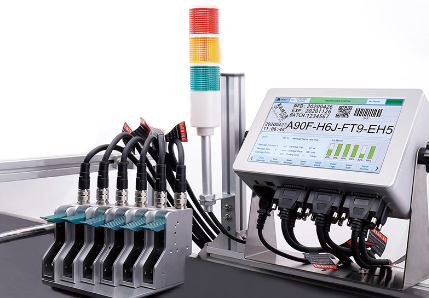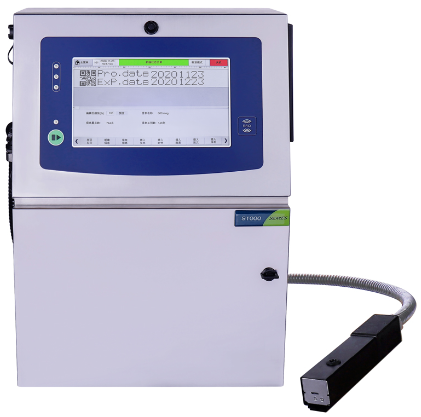For years Continuous Inkjet (CIJ) technology has been manufacturing’s preferred solution for industrial marking and coding. But with recent advances in Thermal Inkjet (TIJ) technology, could that all be about to change?
Originally developed for the publishing industry, CIJ became the go-to technology for industrial marking and coding. It can print at high speeds, for a wide variety of applications and on almost any surface.
There are a lot of rival technologies out there: Laser, Thermal Transfer, Drop on Demand to name just a few. But it’s TIJ that has come a long way over the past decade; and is now challenging CIJ’s dominance of the market.

With CIJ, a high-pressure pump pushes ink through nozzles on the printhead, creating a continuous stream of ink drops. Within this stream, the printer electrically charges the individual drops that will form the printed text. A magnetic field inside the printhead then deflects these charged drops towards their target location on the substrate. The majority of drops have no charge and so don’t get deflected. These land inside the printhead and are returned to the ink supply to be recirculated.
TIJ systems use an ink cartridge consisting of hundreds of tiny nozzles which each contain a heating element. When a current is passed through a nozzle’s heating element it warms the ink, expanding it into a bubble. This creates pressure, pushing the ink on the bubble’s surface through the nozzle and on to the substrate.

S1000 Series Continuous Inkjet Printer
CIJ printers are complex machines, with a lot of moving parts. You need training to use them, and trained technicians to install and maintain them. In contrast, TIJ printers are far simpler, modular systems that don’t need servicing.
Early TIJ systems could only print at speeds of up to 30 m per minute. That’s no longer the case. CIJ still prints at greater speeds than TIJ, but TIJ can now print at around 100 m per minute. That’s more than fast enough for c. 90% of production lines.
TIJ scores highly here. TIJ printers consume up to 80% less power than CIJ options. They also use minimal solvents, helping to create a safe workplace. In contrast, solvent is the main consumable for CIJ printers. It evaporates into the air all the time the printer is running, releasing on average 4-6 ml of solvent into the atmosphere every hour.
The first TIJ printers had a throw distance of 1 or 2 mm, so could only print on flat surfaces and at close proximity. In comparison, with CIJ the high velocity of the ink droplets allows for a throw distance of as much as 50 mm; although 8-10 mm is the typical throw distance used as this is the range at which CIJ delivers optimum code quality. But TIJ has come a long way with its cartridge and nozzle design to achieve a typical throw distance of 5 mm. edding compact printers have taken that even further, equalling the throw distance of many CIJ machines at 8 mm - and so can print at high resolution even on curved surfaces.
Frequent maintenance and cleaning mean more downtime for CIJ compared to TIJ systems. CIJ printers also take several minutes to start up, so users often keep them running all day to avoid further downtime. Start-up and shut down takes seconds with TIJ printers, so users can simply turn them on and off as needed.
CIJ systems are bulky, occupying more line space than TIJ alternatives.
TIJ is the economic choice. There’s no need for an expensive service contracts due to a service-free design. Negligible maintenance costs also mean you achieve true cost per print. The exception is for very high print runs. A TIJ ink cartridge can manage a print run of up to 500K before needing changing. For the 10-15% of manufacturers who have print runs in excess of 500K-1M/per month, CIJ would seem like the more cost-effective option. However, you also need to take production uptime into account when calculating the costs of running a CIJ printer versus a more reliable TIJ system.
A CIJ printer which uses pigmented or specialised inks cannot be switched off for longer than 15-20 minutes, due to the risk of the ink drying and setting in the mechanical parts. This then affects the operation of parts such as pumps and nozzles, resulting in costly servicing of the printer. Also, often CIJ printers can be switched off by mistake by operators, causing downtime and unbudgeted costs as it takes several minutes to start them up again.
TIJ has always won on maintenance. TIJ printers require zero servicing and minimal cleaning. If there’s a problem, you simply change the ink cartridge, which takes seconds. CIJ printers are far more complex. They need frequent cleaning and regular maintenance by trained technicians, causing more production downtime.
Get in touch with us to learn more about TIJ printers and CIJ printers.
Copyright © Docod Precision Group Co., Ltd. All Rights Reserved | Sitemap 粤ICP备19111939号